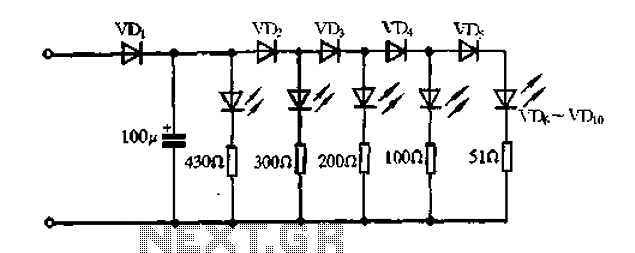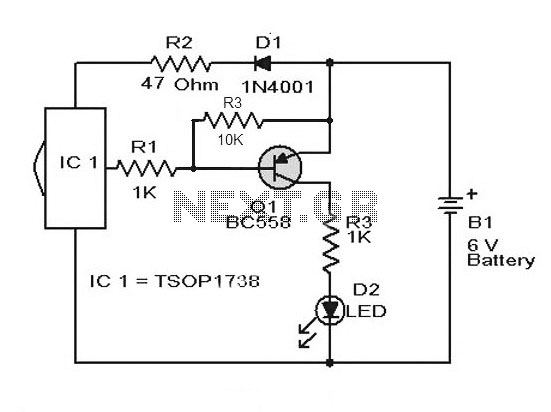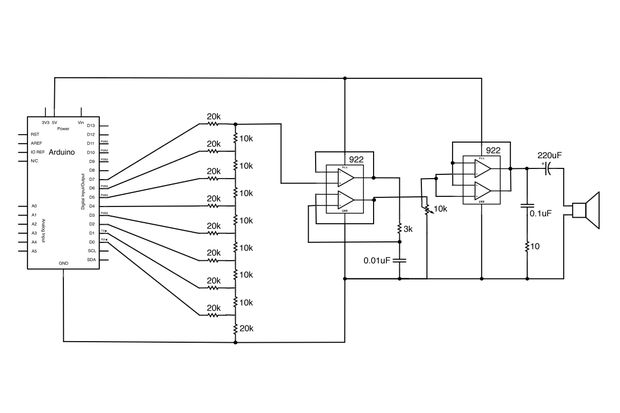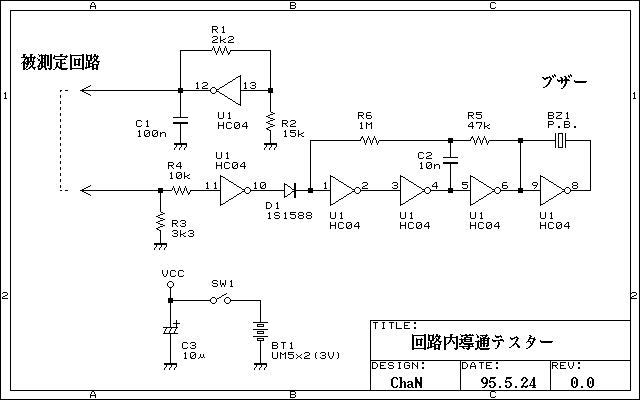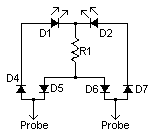
UTP cabel tester
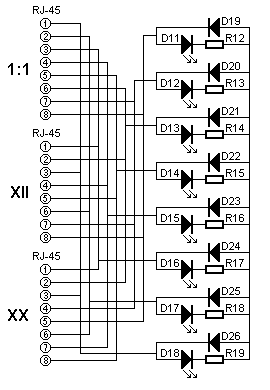
The UTP Cable Tester is designed for multiple applications, primarily to test UTP network cables. It can also assist in identifying the correct cable from a large bundle of similar cables. The circuit can be adapted to test any type of cable with varying numbers of wires, provided it has the appropriate connectors. The tester consists of two small boxes that connect to each end of the cable being tested. One box contains a signal generator powered by a standard 9V battery, while the other box features eight LEDs that indicate the condition of the cable. The operation principle is straightforward: a functional cable will display a single walking light pattern. If the lights illuminate in an incorrect order, it indicates that some wires are swapped in one or both connectors. If one or more lights do not illuminate, it signifies that one or more wires are cut. If two or more lights illuminate simultaneously, it indicates that two or more wires are shorted together. This tester is basic and cannot detect separated pairs; thus, even if all pins are connected and the expected walking light pattern is displayed, it does not guarantee that the pairs remain intact within the cable. Mixing or separating pairs can lead to network issues at higher speeds and over longer distances, which the UTP tester will not indicate. Some network adapters and switches have an auto-polarity feature, allowing for the swapping of white and colored wires in a twisted pair without causing issues. A cable with wires 1 & 2 or 3 & 6 swapped may show as faulty on the UTP Cable Tester, yet it might still function in certain cases. It is not advisable to rely solely on the network adapter and switch's ability to sense polarity, as replacing one device later may lead to complications. The display box includes three RJ-45 connectors: the first, labeled 1:1, is for testing Straight Through or Patch cables; the second, labeled Xll, is for testing 10baseT and 100baseTX Cross cables; and the third, labeled XX, is for testing 100baseT4 cross cables. The signal box is powered by a 9V battery (B1), which can be turned on and off using switch (S1). Diode (D2) protects the circuit from incorrect battery connections. The current draw is minimal, around 5mA, ensuring a long battery life. The IC 4060 generates a low frequency at its output, which is not critical as long as it allows for the identification of signals in the wrong order on the display box. A frequency of approximately 3Hz is selected, resulting in a total loop time of about 3 seconds. This frequency can be adjusted by changing the value of capacitor (C1) as needed. The low frequency is fed into the IC 4017, a decade counter with ten outputs, only one of which is high at any given time. Each low-to-high transition advances the counter to set the next output high. Although the counter has ten stages, only eight LEDs are used on the display box. One of the remaining stages flashes an LED on the signal box to indicate its operation, while the tenth stage remains unused, creating a short pause in the light pattern on the display box. A programmable controller, such as a PIC16F84 or AT89C1051, could have been utilized for this purpose, but a discrete approach was deliberately chosen.
The UTP Cable Tester circuit can be broken down into several key components that work in conjunction to provide effective cable testing capabilities. The signal generator circuit, powered by a 9V battery, utilizes the IC 4060 to produce a low-frequency square wave output. This frequency is essential for driving the LED indicators in a recognizable pattern, allowing users to easily identify the status of the cable being tested.
The output from the IC 4060 is fed into the IC 4017 decade counter, which sequentially activates its outputs based on the incoming clock signal. Each output corresponds to one of the eight LEDs in the display box. The LEDs are arranged in a linear fashion, illuminating in a walking pattern to indicate proper cable continuity. The design ensures that only one LED is lit at any given time, which helps in diagnosing issues such as wire swaps or shorts. The inclusion of a visual indicator on the signal box confirms that the tester is powered and operational.
The RJ-45 connectors are crucial to the tester's functionality, allowing for versatile cable testing. Each connector is designed for specific cable types, ensuring that the tester can accurately assess both straight-through and crossover configurations. The use of diodes and other protective components further enhances the reliability of the circuit, safeguarding it from potential damage caused by incorrect connections.
In summary, the UTP Cable Tester is a practical tool for network technicians, providing essential diagnostics for UTP cables. Its straightforward design, combined with the use of discrete components, allows for effective testing while maintaining ease of use and reliability. The ability to adapt the circuit for various cable types and the inclusion of visual indicators make it a valuable asset in network maintenance and troubleshooting.The UTP Cable Tester can be used for many purposes. Mainly to test a UTP network cables of course. However it can also be used to find the right cable in a large bundle of identical looking cables. In fact the circuit can be used or adapted to test any type of cable of any number of wires, provided that the tester is equipped with the appropriate connectors. The UTP Cable Tester consists of 2 tiny boxes that have to be connected to each end of the cable under test. One of the boxes contains a signal generator, powered by a standard 9V battery. The other box contains 8 LEDs that indicate the cable`s condition. The principle of operation is very simple: A good cable will show a single walking light. However when the lights are lit out of order you`ll know that some wires have been switched in one or both of the connectors.
If one or more lights don`t light you`ll know that one or more wires are cut. If two or more lights light up simultaneously you`ll know that two or more wires are shorted together. This is only a simple tester and therefore it can not detect separated pairs. Even if all pins are connected, showing the expected walking light pattern it does not automatically mean that the pairs are still pairs in the cable.
Separating or mixing pairs will cause network problems on higher speeds and longer cables. The UTP tester will not indicate such fault conditions! Some network adapters and network switches have an auto polarity mode. This means that you may switch the white and coloured wires of a particular twisted pair without causing problems. A cable with wires 1 & 2 switched or 3 & 6 switched will indicate false on the UTP Cable Tester but might still function in some cases.
It is not recommended to rely on the ability of the network adapter and network switch to sense the polarity. When one of the devices is replaced by an other one after a while you may be in trouble. The display box has 3 RJ-45 connectors. The first one, marked 1:1, is intended for testing Straight Through or so called Patch cables. The second one, marked Xll, is used for testing 10baseT and 100baseTX Cross cables. The third one, marked XX, is used for testing 100baseT4 cross cables. The Signal Box is powered by a 9V battery B1 which can be switched on and off by switch S1. Diode D2 protects the circuit in case the battery is connected the wrong way up. Current drain is minimal, approximately 5mA, which ensures quite a long battery life. The IC 4060 generates a low frequency at its output. The exact frequency is not that important, as long as you can identify signals in the wrong order on the Display box.
I choose a frequency of about 3Hz, resulting in a total loop time of approximately 3 seconds. You may change the frequency by changing the value of C1 to suit your own needs. This low frequency is fed to the input of the IC 4017, which is a decade counter. It has 10 outputs, only one of which will be high at any time. Every time the counter receives a low to high transition it advances to set the next output high. It has 10 stages, and we need only 8 LEDs on the Display Box. One of the remaining stages is used to flash a LED on the Signal Box to indicate that it is functioning. The 10th stage is obsolete, and no LEDs will be on during that time. This way a short pause is introduced on the light pattern on the Display Box. I could have used a programmable controller like a PIC16F84 or AT89C1051. The program would be quite simple. I deliberately chose the discrete approach thoug 🔗 External reference
The UTP Cable Tester circuit can be broken down into several key components that work in conjunction to provide effective cable testing capabilities. The signal generator circuit, powered by a 9V battery, utilizes the IC 4060 to produce a low-frequency square wave output. This frequency is essential for driving the LED indicators in a recognizable pattern, allowing users to easily identify the status of the cable being tested.
The output from the IC 4060 is fed into the IC 4017 decade counter, which sequentially activates its outputs based on the incoming clock signal. Each output corresponds to one of the eight LEDs in the display box. The LEDs are arranged in a linear fashion, illuminating in a walking pattern to indicate proper cable continuity. The design ensures that only one LED is lit at any given time, which helps in diagnosing issues such as wire swaps or shorts. The inclusion of a visual indicator on the signal box confirms that the tester is powered and operational.
The RJ-45 connectors are crucial to the tester's functionality, allowing for versatile cable testing. Each connector is designed for specific cable types, ensuring that the tester can accurately assess both straight-through and crossover configurations. The use of diodes and other protective components further enhances the reliability of the circuit, safeguarding it from potential damage caused by incorrect connections.
In summary, the UTP Cable Tester is a practical tool for network technicians, providing essential diagnostics for UTP cables. Its straightforward design, combined with the use of discrete components, allows for effective testing while maintaining ease of use and reliability. The ability to adapt the circuit for various cable types and the inclusion of visual indicators make it a valuable asset in network maintenance and troubleshooting.The UTP Cable Tester can be used for many purposes. Mainly to test a UTP network cables of course. However it can also be used to find the right cable in a large bundle of identical looking cables. In fact the circuit can be used or adapted to test any type of cable of any number of wires, provided that the tester is equipped with the appropriate connectors. The UTP Cable Tester consists of 2 tiny boxes that have to be connected to each end of the cable under test. One of the boxes contains a signal generator, powered by a standard 9V battery. The other box contains 8 LEDs that indicate the cable`s condition. The principle of operation is very simple: A good cable will show a single walking light. However when the lights are lit out of order you`ll know that some wires have been switched in one or both of the connectors.
If one or more lights don`t light you`ll know that one or more wires are cut. If two or more lights light up simultaneously you`ll know that two or more wires are shorted together. This is only a simple tester and therefore it can not detect separated pairs. Even if all pins are connected, showing the expected walking light pattern it does not automatically mean that the pairs are still pairs in the cable.
Separating or mixing pairs will cause network problems on higher speeds and longer cables. The UTP tester will not indicate such fault conditions! Some network adapters and network switches have an auto polarity mode. This means that you may switch the white and coloured wires of a particular twisted pair without causing problems. A cable with wires 1 & 2 switched or 3 & 6 switched will indicate false on the UTP Cable Tester but might still function in some cases.
It is not recommended to rely on the ability of the network adapter and network switch to sense the polarity. When one of the devices is replaced by an other one after a while you may be in trouble. The display box has 3 RJ-45 connectors. The first one, marked 1:1, is intended for testing Straight Through or so called Patch cables. The second one, marked Xll, is used for testing 10baseT and 100baseTX Cross cables. The third one, marked XX, is used for testing 100baseT4 cross cables. The Signal Box is powered by a 9V battery B1 which can be switched on and off by switch S1. Diode D2 protects the circuit in case the battery is connected the wrong way up. Current drain is minimal, approximately 5mA, which ensures quite a long battery life. The IC 4060 generates a low frequency at its output. The exact frequency is not that important, as long as you can identify signals in the wrong order on the Display box.
I choose a frequency of about 3Hz, resulting in a total loop time of approximately 3 seconds. You may change the frequency by changing the value of C1 to suit your own needs. This low frequency is fed to the input of the IC 4017, which is a decade counter. It has 10 outputs, only one of which will be high at any time. Every time the counter receives a low to high transition it advances to set the next output high. It has 10 stages, and we need only 8 LEDs on the Display Box. One of the remaining stages is used to flash a LED on the Signal Box to indicate that it is functioning. The 10th stage is obsolete, and no LEDs will be on during that time. This way a short pause is introduced on the light pattern on the Display Box. I could have used a programmable controller like a PIC16F84 or AT89C1051. The program would be quite simple. I deliberately chose the discrete approach thoug 🔗 External reference
